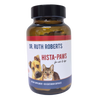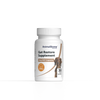We're always trying to find the right mix of what keeps our furry friends healthy and the food we pick for them. Lately, there's been a lot of talk about whether we should feed our dogs raw, natural diets or stick to commercial or homemade cooked food. Some people think dogs should eat raw because it's what their wild ancestors did, saying regular pet food might lose good stuff when cooked. So let’s talk about it. Let’s look closely at the good and the worrisome aspects of natural and raw food: Is this kind of diet really the best for our four-legged pals?
In this blog, we're bringing up some research, separating myths from truths, and uncovering the real deal about raw diets for dogs. So, if you've been wondering whether natural or raw is the way to go for your dog's health, you're in the right place. Let's cut through the noise and explore what these diets truly mean for our canine companions.
What is Considered as Natural Diets for Dogs?
In the US, The concept of "natural" in the context of commercial pet food refers to the definition set by the Association of American Feed Control Officials (AAFCO). According to AAFCO regulations, pet food labeled as "natural" must, at least, be preserved with natural preservatives. What does this mean? While the use of natural preservatives is a key criterion for the "natural" label, it doesn't necessarily mean that the entire composition of the pet food is entirely natural. Other non-natural ingredients and processing methods may be included in the production of the so-called "natural" pet food.

Then there comes the gap between the regulatory definition of "natural" and how pet owners interpret the term. The trend in natural pet food emphasizes the incorporation of whole ingredients such as meats, fruits, and vegetables, steering clear of heavily processed components, refined grains, fiber sources, and byproducts. As pet parents, it's important for us to look for options that match what we believe is natural and good for our pets. If we don't fully understand the impact of our choices, there's a chance we might pick diets that lack important nutrients or could even be harmful to our pets' health.
Raw Food Diet for Dogs: Is It The Best Option?
The rationale behind raw food diets lies in the belief that dogs and cats, being carnivores, evolved by consuming raw foods. It is argued that commercial pet foods, subjected to heat-processing, may lack natural and nutritionally beneficial elements. While these claims might appear convincing to pet owners, they often fail to withstand scientific scrutiny.
Raw food diets can be categorized into three main types:
- Commercially Available Complete Raw Food Diets: These are ready-made raw food diets that can be purchased commercially.
- Homemade Complete Raw Food Diets: This category includes diets prepared at home, such as the Bones and Raw Food (BARF) diet, the Ultimate diet, and the Volhard diet.
- Combination Diets: These diets involve a mix of commercially available grain-and-supplement mixes along with raw meat, offering a combined approach.
Advocates of raw diets for dogs often claim various health benefits associated with this feeding approach, although it's essential to recognize that the scientific backing for these assertions may vary. One commonly cited advantage is the improvement in coat and skin health, attributed to the natural fats and oils found in raw meat. Additionally, proponents suggest that a raw diet may reduce allergies and sensitivities in dogs, often linked to certain ingredients present in commercial dog foods. The act of chewing on raw bones is believed to contribute to better dental health by minimizing plaque and tartar buildup, emulating the natural chewing behavior of dogs in the wild.
The Risks of Raw Food Diets
On the flip side, critics express concerns about the potential risks associated with a raw food diet. In an effort to present unbiased information, nutritional analyses were conducted on multiple raw food diets. These were then compared against the nutrient standards set by the Association of American Feed Control Officials (AAFCO). The outcomes revealed diverse nutritional imbalances and deficiencies in the scrutinized diets, raising additional worries regarding bacterial contamination.
In addition to these concerns, a study conducted by researchers at the University of Bristol has identified another potential risk associated with feeding dogs a raw food diet. The study, involving 600 healthy pet dogs, discovered that dogs consuming raw (uncooked) meat faced an increased risk of excreting E. coli bacteria resistant to the antibiotic ciprofloxacin. E. coli is a bacterium known for causing food poisoning and is a common culprit behind urinary tract and bloodstream infections in both humans and animals.
This significant association between a raw food diet and the excretion of ciprofloxacin-resistant E. coli raises serious health implications. The antibiotic resistance observed suggests potential challenges in treating infections that may arise from exposure to these bacteria. Consequently, this adds another layer of concern to the debate around raw food diets for dogs, emphasizing the need for thorough consideration and awareness of associated risks before opting for such dietary choices.
Raw VS Cooked Food for Dogs
The idea of providing our pets with whole ingredients doesn't necessarily have to align with the concept of feeding them based on ancestral diets. In the context of pet food, the term "natural" primarily pertains to the quality of ingredients rather than the cooking process. Natural pet food promotes the inclusion of whole foods such as meats, fruits, and vegetables, while steering clear of heavily processed components, refined grains, and byproducts.

Providing your canine companion with a homemade or cooked diet can be a wholesome and nutritious way to ensure their well-being. Homemade meals can be prepared using fresh and unprocessed ingredients, preserving the natural nutrients that may be lost during the commercial cooking and manufacturing processes. Cooked food for dogs allows you to serve food that is rich in essential vitamins and minerals vital for your dog's overall health. You can choose high-quality, fresh, and locally sourced ingredients, avoiding fillers, preservatives, and artificial additives commonly found in commercial dog foods. This allows you to create a well-balanced and wholesome meal for your dog.
Cooking makes nutrients in pet food more digestible. It breaks down cell walls in ingredients, making it easier for pets to absorb essential nutrients from the food. Moreover, cooking helps retain more nutrients in the food compared to raw feeding. Some nutrients become more bioavailable and easily absorbed by the pet's digestive system after the cooking process. Raw diets may pose safety concerns on the potential contamination of raw meat with harmful bacteria such as Salmonella or E. coli. Cooked food eliminates these risks.
Moreover, cooked food has been linked to a significant increase in a dog's lifespan. A scientific study found that a 20% increase in longevity was observed for dogs on a homemade diet. In particular, a home-cooked diet was shown to add up to 32 months, or nearly 3 years, to a dog's life expectancy. Cooking not only makes nutrients more digestible but also contributes to the overall well-being and extended life of your furry friend.
a scientific study that found a 20% increase in longevity for dogs on a homemade diet. In particular, cooked food for dogs was shown to add up to 32 months, or nearly 3 years, to a dog's life expectancy.
Key Takeaway
When choosing the optimal diet for our pets, the focus often shifts to natural and raw food options. Defining what "natural" means in the context of pet food becomes crucial, considering the disparity between regulations and pet owners' perceptions. Prioritizing foods aligned with our beliefs about pet well-being involves incorporating whole ingredients into their meals for sustained health.
While raw diets can enhance pets' fur, skin, and address allergies, it's essential to acknowledge concerns and studies pointing out potential drawbacks. Issues such as nutrient deficiencies and the risk of bacterial contamination, including antibiotic-resistant strains, highlight the need for careful consideration.
In our search for the best way to feed our dogs, you can learn about feeding a homemade or cooked meals for your pet and its potential benefits. Cooking the food not only makes it easier for dogs to get the good stuff from it, but it also helps with safety, avoiding the problems linked to raw diets. A cool finding from a science study shows that dogs on homemade diets can live 20% longer – that's like almost 3 more years of being healthy and happy. So, cooking for our dogs might really be a good idea for their health and how long they get to enjoy life.
















